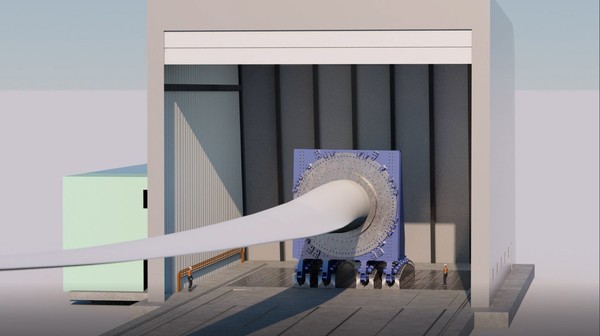News Release from Fraunhofer-Institut für Windenergiesysteme IWES
Wind Industry Profile of
Construction begins on superlative rotor blade test bench
Once complete, the bench will be used to test state-of-the-art prototypes measuring 115 m in length and even more. Some €19 million are set to be invested in the project bearing the name “Future Concept for Fatigue Strength of Rotor Blades Phase II”, which will see the construction of a testing infrastructure with a modular test block and the development of new methods for investigating subsegments. The site at the Fischereihafen offers the advantage that long blades which have been transported by sea have only a short distance to travel to the testing hall.
In the past five years, the dimensions of the latest generation rotor blades have grown from almost 90 m to 115 m and now measure the same length as a soccer field. This lighting-speed development has even exceeded the imagination of industry experts: the Fraunhofer IWES commissioned its 90-m test hall exactly ten years ago. The dimensions have continued to grow and the two existing halls enjoy good capacity utilization, yet, up to now, the institute has lacked the appropriate infrastructure to accommodate requests to test XXL blades from international manufacturers. This is now to be remedied at the Bremerhaven site, and the bench is to be commissioned in summer 2022. The Federal Ministry for Economic Affairs and Energy (BMWi) is financing the project to the tune of €14.8 million.
`During the past ten years, the federally funded rotor blade test rigs in Bremerhaven have been used intensively to further develop the technology. As a result, it has been possible to manufacture ever larger and more powerful blades, which have significantly supported the expansion of wind energy use in Germany. The Federal Ministry for Economic Affairs and Energy is therefore also funding the new rotor blade test rig in Bremerhaven – this will enable us to leverage further potential for optimisation in the future, which will benefit the energy transition in Germany`, says Dr. Wolfgang Langen, Head of Unit Energy Research – Project Funding and International Affairs, Federal Ministry for Economic Affairs and Energy.
Rotor blades are key for the performance, reliability and costs of wind turbines. The investments made in assuring the quality of rotor blade development speak for themselves: the 600-ton steel test block which secures the rotor blade can be tilted and the blade can be rotated through 180 degrees on the block via a corresponding device. What’s more, the construction can be expanded and converted should changes to the market make amendments necessary.
The first visible step in the test bench setup is the anchoring of the 175 piles in the sandy soil of the construction site. These ensure that the huge loads which occur during testing are transferred. A gantry crane for lifting the giant rotor blade is designed to carry a load of 120 tons – the equivalent of 20 elephants. The next milestone is the completion of the test hall by the end of the year. The test block and measurement technology will be ready in 2022.

The test block for mounting the blade can be expanded and converted - if increases in length make amendments necessary. (Image: Fraunhofer IWES/gobasil)
Since the testing of a rotor blade can take several months, the third test bench will not only boost capacity but also bolster Bremerhaven as an IWES institute location. The State of Bremen and the Federal Ministry of Education and Research (BMBF) are supporting the infrastructure project with around €4 million in ERDF funding.
`I am delighted to see a further expansion of IWES´ rotor blade test capacities that ensures to meet up to date demands of wind turbine component manufacturers. In order to empower IWES to remain one of the most important research partners for the wind industry and strengthen its position even further, we support the steady enhancement of the unique testing infrastructure in Bremerhaven`, explains Dr. Claudia Schilling, Senator for Science and Ports of the Free Hanseatic City of Bremen.
The rotor blade experts from IWES also hope to make testing more intelligent by developing new methods. One particular focus, for example, is on biaxial testing of complete blades. With this test method, the rotor blade is set in motion along its transverse and longitudinal axes in both the impact and pivoting directions and the structural behavior under load is measured using sensors. This allows simulation of a particularly realistic load distribution.
`Our recently presented SG 14-222 DD turbine with a capacity of up to 15MW features blades with a record-breaking length of 108 m. Blade testing facilities for ultra large Offshore blades are vital to meet internal validation objectives and certification standards, with the final goal of optimizing the design and performance of our wind turbine blades while ensuring its reliability`, sums up Vicente García, Head of SGRE Validation Means Management.
Segmented testing, i.e., the testing of subsegments of the rotor blade, also presents great advantages: the greater eigenfrequencies of the subsegments compared to the entire rotor blade allows considerable reduction of the testing time, in some cases by several months. The goal of these activities is to ensure that the experimental testing of very long rotor blades remains economically viable for manufacturers. As a result, blades can be designed more precisely in future which, in turn, saves costs and weight.
`As a leading research institute for wind energy, we strive to stay one step ahead of the state of the art with our testing methods,`explains Dr. Steffen Czichon, Head of the Rotor Blade Department at the Fraunhofer IWES.
Origin of funding:
Hall construction: BMBF and the State of Bremen/ERDF financing, €4 million
Test bench setup: BMWi, €14.8 million
- Source:
- Fraunhofer IWES
- Author:
- Press Office
- Link:
- www.iwes.fraunhofer.de/...
- Keywords:
- Fraunhofer IWES, Germany, test bench, XXL, rotor blade, wind turbine, Bremerhaven, size, blades, long


























